How to dry laundry in a sustainable way
The quintessential idea of freshly dried laundry is bed sheets hanging on an outdoor clothesline blowing in the breeze against a clear blue sky, but that’s far from the reality of how Americans actually dry their laundry.
Today, 79% of Americans use clothes drying machines at home that are powered by electricity or gas, according to the EPA’s Energy Star report, but the technology of heat-powered drying hasn’t improved much since the 1970s. Dryers are rated the least efficient of all household appliances and cost Americans $9 billion each year in energy costs, according to a Natural Resources Defense Council (NRDC) brief that estimates industry upgrades and household behavior change — like lowering the temperature and reducing drying time — could save Americans up to $4 billion each year and cut 16 million tons of carbon dioxide emissions from dryers, “equivalent to the pollution from three coal-fired power plants.”
If you’re looking for ways to make the chore of laundry an environmentally-friendly (and maybe even enjoyable) practice, we recommend starting with our guide to washing laundry sustainably. And since you’re probably wondering what to do with that soggy load of laundry, we asked the experts and examined the ins and outs of garment drying to provide the most sustainable techniques and products that will keep your sheets soft.
Basic drying tips to save energy and extend life of garments
Just as it is true for washing laundry, the way that you dry your laundry can extend or reduce the life of your garments. The most responsible thing you can do for the planet is to consume less, which necessitates taking better care of what you already have. Don’t wash a garment if it is not dirty, and if it’s just a little musty or wrinkled, try using a steamer, “to freshen it up in between washes,” suggests Corinna Williams, co-founder of Celsious, a sustainable garment care business in Brooklyn.
Energy consumption from drying machines accounts for 6% of household energy consumption and costs residents roughly $100 per year in their electricity bill, which might not sound like a lot on an individual level, but when the majority of Americans dry five loads of laundry each week, it adds up. According to the NRDC, Americans use as much energy drying their clothes as the entire state of Massachusetts and emit 40 million metric tons of carbon dioxide annually doing so. You can use less energy and cut down emissions with simple habit changes, drying techniques and shopping tips that help your towels stay soft and fluffy, save you money and incorporate your laundry routine into holistic sustainable living.
One of the single best things you can do for your clothes, your wallet and the environment is to ditch the dryer altogether. Using drying racks or clotheslines might sound like an added chore, but Patric Richardson, the Laundry Evangelist and author of “Laundry Love: Finding Joy in a Common Chore,” notes that air dried clothes, especially when they are hung from their bottom hems, have fewer wrinkles so you iron less, and their shirt collars and cuffs hold their shape better instead of getting beaten down in a lengthy drying cycle.
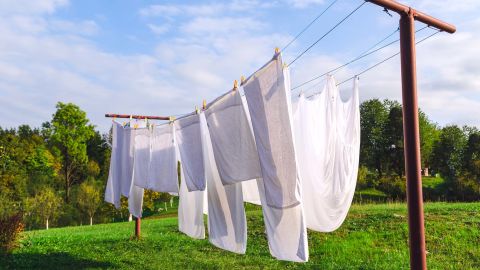
If you have access to a backyard, porch, deck, balcony, fire escape or rooftop, you can set out a drying rack or install an inexpensive clothesline that will save you money in the long term. The last time we checked, fresh air and sunshine were still free. Look for retractable clothesline models to save space and maintain taut wires or cords. You can even DIY a clothesline with wooden or metal beams, clothesline wire or strong cords and metal hooks. Search your local reuse stores for secondhand materials before buying new.
If drying laundry outside isn’t an option, you can opt to bring your clothes indoors to hang dry. If space is limited, take advantage of bathroom shower rods and doorframes to loop hangers over. “We get this idea that in order to hang dry, we need a laundry room the size of Versailles,” laughs Richardson. “I just have one bathroom in a little house. I hang the clothes on the shower rod and set the drying rack in my bathtub.”

There are functional designs made for limited space like retractable indoor clotheslines, vertical folding racks that are stored flush against the wall until needed, and compact racks that can be tucked away in a closet or behind a door when not in use. Look for gently used drying racks in your local Buy Nothing group, and if you live in a city where people put out free items curbside, you might be able to divert an unwanted drying rack from going to a landfill.
Depending on the size of your household and how often you do laundry, air-drying everything you wash might take up a lot of square footage. Hang up laundry before bedtime for overnight convenience, or only wash a few loads at a time to accommodate the size of your space. Don’t forget, the best part of drying indoors is the fresh scent of clean laundry that fills the air.
Reduce temperature and drying time
For some people, using a drying machine is necessary due to mobility issues, household size and limited access to air-drying space. If you cannot avoid using the dryer, there are still steps you can take to reduce your environmental impact, make your garments last longer and save money.
Use a mesh drying bag for your delicates, synthetics and any item that is likely to shed while tumbling in the drum.
Lowering the heat greatly reduces the damage that drying machines do to your garments and it uses less energy, which is well worth the slightly added time to the drying process. For folks using laundromats, Richardson advises drying loads to 95% then “bring them home and hang them up for just a few minutes to finish. Cutting down on your drying a little bit every time really adds up,” he says.
If you drop off at a laundromat for wash and fold services, you can request a specific heat level to be used for your clothes — just ask! If drying laundry yourself, set a timer so you can take your items out of the dryer as soon as they are done. Every time your clothes tumble in the dryer is like a small crucible, so don’t put them through it more than necessary.

Although the practice of line drying clothes under the sun has tapered off in the US, the nostalgia for it lives on in popular artificially scented candles, air fresheners and dryer sheets promising the scent of fresh cotton, soft linen, and clean laundry.
It’s ironic, to say the least, that marketers use the concept of white sheets hanging on a clothesline as a measure of freshness to market dryer sheets that coat clothes in a veneer of artificial toxic fragrance.
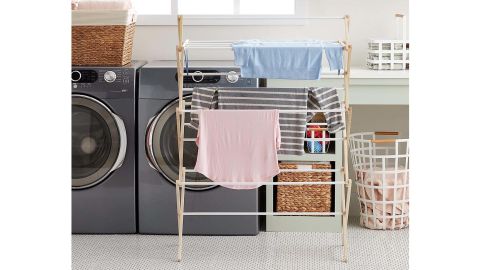
The marketing behind dryer sheets is the same as liquid fabric softener, equating cleanliness with intense artificial fragrances. That cozy scent you smell outside of laundromats is probably a sign of volatile organic compounds (VOCs) found in laundry softeners and dryer sheets polluting the air with acetone, ethanol, α-pinene, linalool and D-limonene.
These compounds can have harmful effects on public health and the environment on their own, but they can also react with ozone to create other hazardous air pollutants like formaldehyde, acetaldehyde and ultrafine particles. Among some of the toxins detected from dryer vents are two chemicals, acetaldehyde and benzene, that are classified carcinogens that have no safe exposure level measured by the EPA.
Dryer balls are reusable alternatives to single-use dryer sheets that can reduce drying time and can be inexpensive, good for the planet and safe for human health. They work to reduce static electricity by gently separating garments and improving air flow, allowing the heat to dry clothes more efficiently and reduce cling.
Wool and silicone dryer balls have grown in popularity but they aren’t as sustainable as they are marketed to be. Silicone is a plastic and unless it is sourced from recycled materials, it contributes to the fossil fuel industry. Plus, synthetic dryer balls tend to be noisy while tumbling in the drum. Wool is praised for its natural fibers and durability but as a subset of animal agriculture, the wool industry has a moderate carbon footprint and contributes up to 28.7 kilograms of greenhouse gas emissions for a single kilogram of wool. Dryer balls made from new wool are much less harmful than conventional dryer sheets but we recommend opting for dryer balls made from renewable materials like organic cotton, bamboo and repurposed wool.
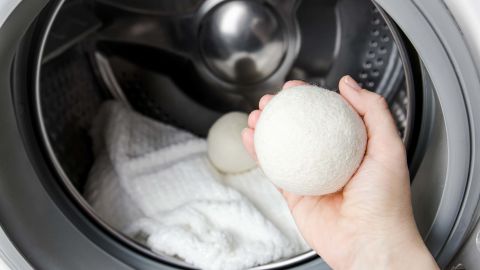
There are easy DIY dryer ball methods you can make at home in minutes. Richardson recommends aluminum dryer balls, made by rolling up a one-yard sheet of aluminum foil into a tennis-sized ball to remove static in the dryer for up to 65 loads. A few sheets of aluminum foil are cheap and sustainable because aluminum is considered a forever metal that can be endlessly reused and recycled. Replace the ball after a few months, depending on how often you run the dryer, when it becomes smooth and shiny and the size of a walnut.
Another method is using the mismatched socks you have likely accumulated during your laundry tenure. Simply roll one sock into itself in a tight ball, slip into another sock and repeat until the desired size ball is achieved (this will vary on the material of the socks) and secure with a safety pin.
If you want to add a natural scent, you can drop essential oils onto the inner sock, toss in a sachet of fragrant herbs like lavender or rosemary into the dryer, or use a scented natural fabric softener during the wash.
Richardson vows that good quality laundry soap and a delicate cycle or hand washing are enough for dry clean only garments. Dry cleaners use chemical solvents instead of water and detergent to clean garments like wool, silk and formal apparel. These solvents include harmful chemicals like tetrachloroethylene and perchloroethylene (PERC), the latter of which is the most common dry cleaning solvent in the US. According to research, “PERC is a reproductive toxicant, neurotoxicant, potential human carcinogen and a persistent environmental pollutant,” posing great risk to dry cleaning workers who inhale and touch the solvents, as well as customers who bring their dry cleaned garments home.
Alternatives to dry cleaning like steam washing use filtered water to gently steam clean the garments. You can incorporate spritzing your garment with a spray bottle of cheap vodka before or after steaming to remove any unwanted smells. Spot treat inside the garment lining for sweat marks or stains using a soft recycled toothbrush. You can use a nontoxic at-home dry cleaner kit designed for delicate fabrics to extend the care of your dry cleaned items, especially suits and formal attire.
Drying laundry involves fewer additives than washing. Sustainable drying is about minimizing electricity usage, turning down the heat and shortening the cycles, rather than adding more products to your drying routine.
The trick here is to set yourself up for success with sturdy, long-lasting equipment that will function for years to come, whether you’re drying indoors or outdoors. We’ve selected high quality options for air-drying, refreshing and preserving your garments, prioritizing sustainable packaging, responsible sourcing and budget-friendly solutions.
$28 at Coyuchi
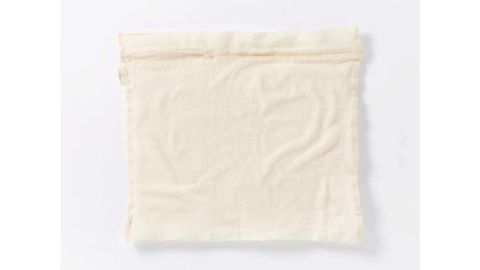
The Coyuchi organic cotton mesh laundry bag prevents snagging, pilling or wearing down in the dryer. Available in medium (16-inch x 18-inch), large (22-inch x 24-inch) and extra large (16-inch x 26-inch x 13-inch). It can be transferred from the washer to the dryer. Made with 100% organic cotton grown and woven in India, the bag is GOTS Certified and packaged in a polybag made with 100% recycled content of pre-consumer waste.
$14 at Totally Plastic Free
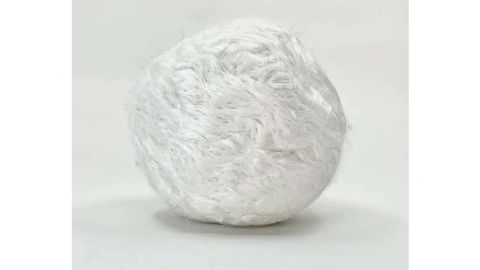
Dragonfly bamboo dryer balls replace single-use dryer sheets to soften fabric, reduce static and wrinkles and cut down drying time by an average of 25% per load. These handmade dryer balls are reusable, will last up to 1,000 loads and can be scented with essential oils. PVC-free and hypoallergenic, they’re made from 100% natural white bast bamboo fiber (they are not bleached). The recommended use is 3 balls per load of laundry but more balls will increase drying time.
$14 at Package Free

Cleaning Essentials’ spray bottle is made from glass with a plastic spray top that has three trigger sprayer settings: spray, stream and off. Each 16-ounce bottle is recyclable, made from recycled glass. Separate the sprayer from its bottle and clean before disposing. The plastic nozzle is #5 recyclable polypropylene. This product is 100% package free.
$5.39 at The Container Store
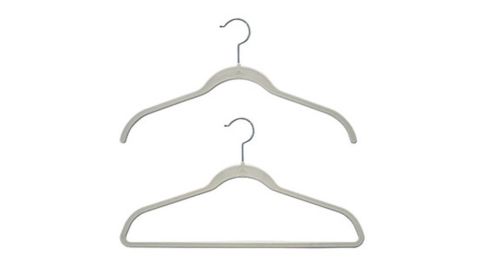
Joy Mangano’s lightweight huggable hangers provide a slim ¼-inch profile that’s ideal for small closets. Made with a non-slip velvety finish that prevents clothing from slipping off the hanger and protects delicate garments. With a slim, compact profile that helps to conserve precious space in your closet, these lightweight hangers are strong enough to hold winter coats. Sold in packs of 10.
“You have to get the Joy brand velvet hangers,” Richardson implores for people with limited closet space. He notes that some velvet hangers are not waterproof and fall apart when used to hang wet clothes. “I know that Joy ones you can get wet,” he assures.
$62 at The Laundress
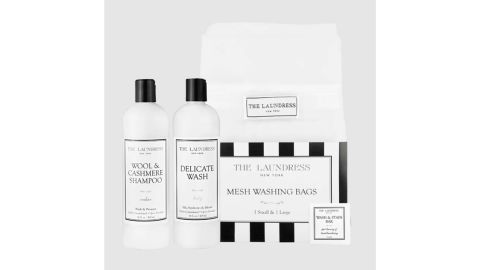
The Laundress dry cleaning detox kit comes with a wool and cashmere shampoo, delicate wash, wash and stain bar and mesh bag bundle to care for dry clean items at home. Ideal for wool, cashmere, silk, synthetics and blends, the kit is made with plant-derived formulas with no unnecessary additives.
$6.29 at Amazon
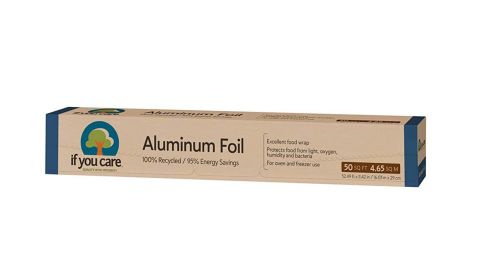
If You Care’s 50-square-foot aluminum foil is made from 100% recycled tin foil which uses 95% less energy to produce than traditional tin foil. Roll a 1-yard sheet into a tennis-sized ball and add to the dryer to remove static electricity for 65 loads. Packaged in a recycled cardboard paper box.
“If I had a tip that would make you call me the laundry genius, it’s this,” Richardson says in his video tutorial on how to make an aluminum dryer ball. “I don’t like things that leave any sort of film on your clothes or leave anything behind, but I realize that static is an issue. So what do you do? You make an aluminum foil ball… You have all of the supplies you need already in the house, so it’s a super easy trick.”
$69.95 at Vermont Country Store
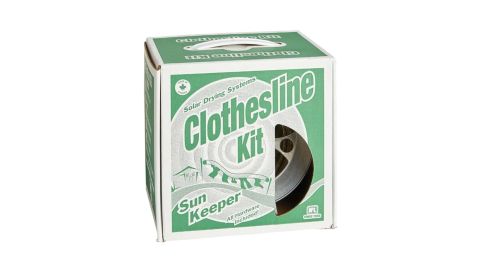
Sun Keeper’s clothesline kit includes 100 feet of PVC-coated clothesline to create a 50-foot long loop, two 6-inch zinc pulleys, two heavy-duty screw-in metal hooks, a line tightener and line divider that are completely rustproof. The anchoring eyelet keeps the PVC-coated clothesline from twisting. 950-pound weight capacity. Made from zinc (pulley), aluminum, plastic (divider), steel (hooks and joiner), steel core with PVC coating (wire).
$25 at Nona
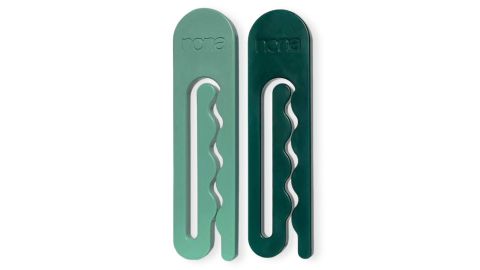
NONA’s ocean plastic clothespin is an ultra-durable clothespin made from recycled ocean plastic and made in a sturdy, mono-form shape that’s practically unbreakable. Sold in packs of 30 and 40, the clothespins are BPA-free, UV resistant, easy to clean and recyclable.
$19.99 at Clotheslines.com
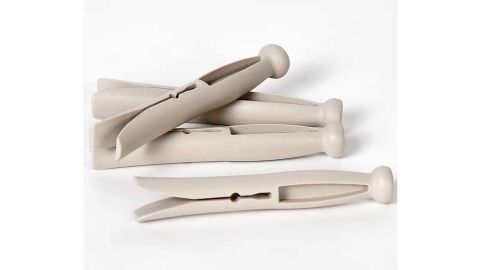
Grandma’s recycled plastic clothespins are made from 100% agricultural polyethylene plastic bale wrap from local farmers. Sold in packs of 36, they’re weatherproof, UV stabilized for sun protection and resistant to rust, mold and mildew.
$29.99 at Amazon
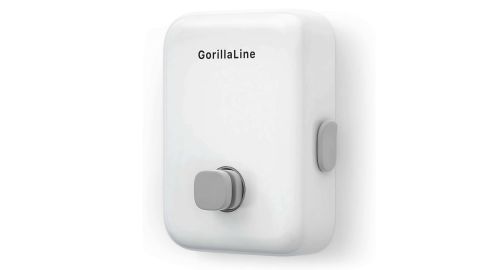
GorillaLine’s heavy-duty retractable clothesline is made from stainless steel and coated in white plastic. They hold up to 40 pounds and can be used indoors or outdoors. Comes with screws for wall mount.
$13.95 at REI
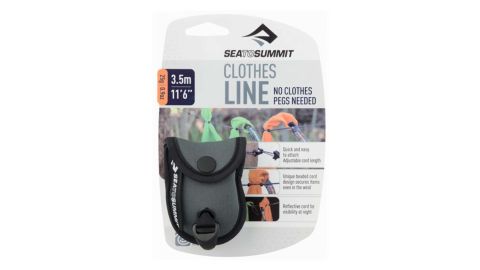
Sea to Summit’s Lite Line clothesline has a dual cord with beads to hold garments in place while drying and eliminating the need for clothespins. Ideal for camping and travel, the line stows in the included nylon pouch, only weighs 1.3 ounces and stretches 11 feet and 6 inches.
$49.99 at The Container Store
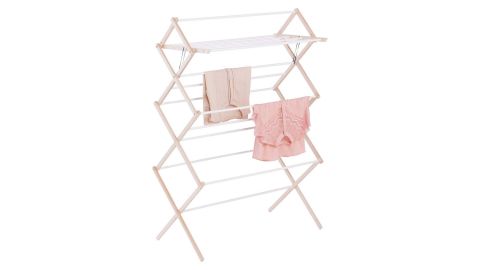
The Container Store’s 15-dowel wooden clothes drying rack is a convenient and space-efficient place for drying a variety of garments and laundered items. Made in the US from solid poplar hardwood, each dowel is coated in bonded acrylic to prevent mildew and warping. The rack provides 41 linear feet of drying space and folds for compact storage.
“I love the drying rack at The Container Store,” gushes Richardson. “It has these long wooden white rungs, and I set it in my bathtub to air dry my laundry. ”
$66.48 at The Home Depot

The Minky Multi Indoor Drying Rack is simple to use with its auto opening and closing mechanism. It can hold two loads of laundry and has a large 82-foot capacity with 51 crossbars. Made from strong tubular steel construction to ensure it remains safe and stable even when fully loaded with wet laundry, its maximum weight is 55 pounds. The rack is ideal for drying long hanging items, and its wheels allow it to be moved when loaded.
$18.99 at Oxo
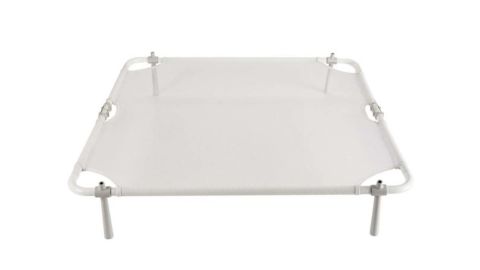
Good Grips’ mesh folding sweater dryer dries delicate clothes quickly without stretching or creasing. It offers a generously sized mesh drying surface for clothes to aerate while lying flat. Ideal for heavier delicates like sweaters and blouses. Legs are offset from corners to provide maximum drying space even on smaller surfaces like countertops, washing machines or dryers.
“This sweater drying rack by OXO is a new favorite!” says Williams. “ We love that it’s collapsible, so you can stash it away when not in use. We always advise laying wool sweaters flat to dry to avoid misshaping them. You can lay them on a clean towel, but this rack does a much better job.”
$109 at Pottery Barn
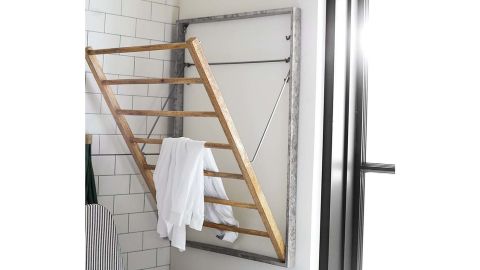
Pottery Barn’s wall-mounted laundry drying rack — made from galvanized metal (powder coated mild steel) and mango wood — is stylish and functional. Weighing 9 pounds, it’s Fair Trade Certified, sustainably sourced and includes mounting hardware for easy setup.
$239 at Jiffy Steamer
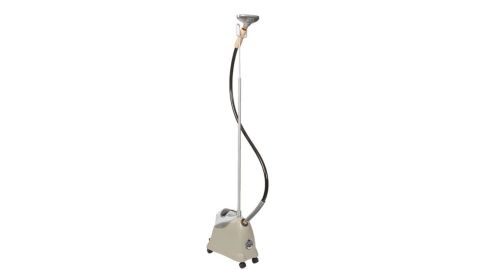
The Jiffy Steamer J-2000M can quickly and efficiently remove wrinkles from most fabrics, perfect for home or light commercial use. “We use this Jiffy stand-up steamer, which works wonders for our laundry business,” Williams recommends. “It’s meant for commercial or at-home use, so if you have the space to store it and need to steam a lot of garments per day, it’s worth the investment.”
$69.99 $59.99 at Amazon
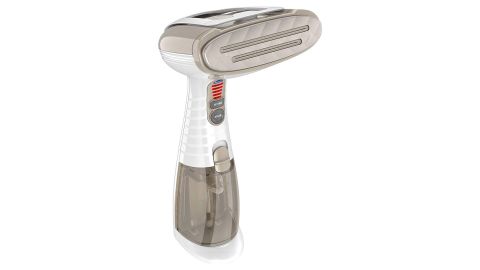
When we tested 13 clothes steamers the Conair Turbo Extreme had the best balance of ease of use and functionality by far. Its wide range of steam levels and nifty attachments along with a well-balanced design make it the best clothes steamer we’ve ever tried.
$180 at Celsious
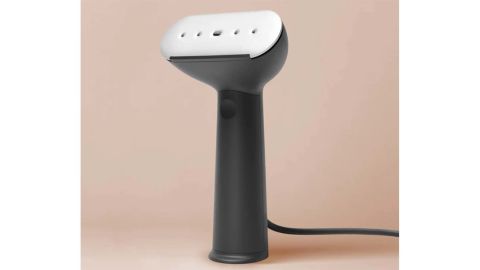
Steamery’s Cirrus 3 iron steamer is a sleek dual function device that can be used to steam and iron. An anti-puff feature minimizes water leakage and it holds enough water to steam three garments before refilling. “Another steamer we like for at-home use is the Cirrus 3 Iron Steamer by Steamery,” says Williams. “Not only does it steam beautifully, but it can also be used to iron pocket flaps, hems and collars (something regular steamers can’t do).”